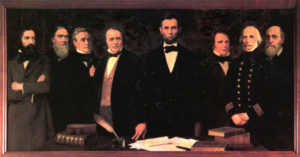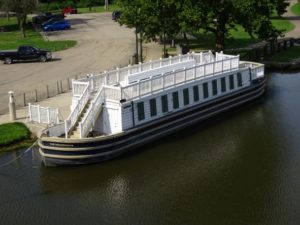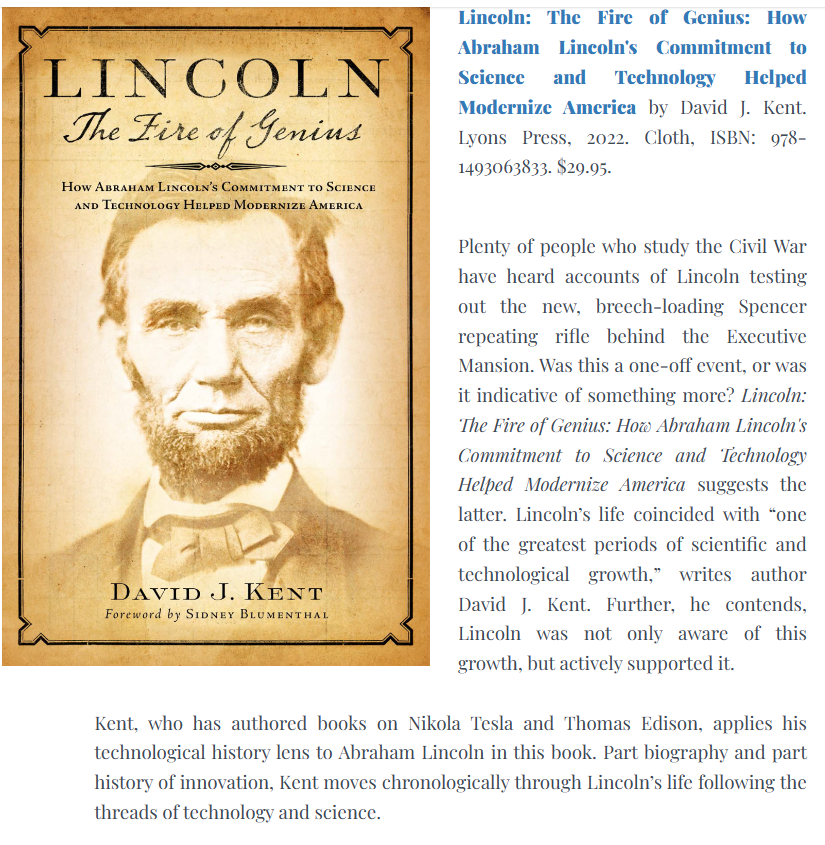 In Abraham Lincoln’s lecture on Discoveries and Inventions, he discussed how the ingenuity of man had made life easier for the growing millions of Americans. Early in the lecture he used biblical language to relate how the need for clothing led to technological advances, as was also true for communication. At one point he turned to transportation. As with clothing, he stressed the advantages of inventive, productive labor that improves the human condition. Here the goal was to advance beyond human motive power to get from place to place. Inventive thought led to development of the wheel, then wagons on land and boats on water. These were powered by animals such as horses, mules, and oxen on land, or wind and paddles on the water.
In Abraham Lincoln’s lecture on Discoveries and Inventions, he discussed how the ingenuity of man had made life easier for the growing millions of Americans. Early in the lecture he used biblical language to relate how the need for clothing led to technological advances, as was also true for communication. At one point he turned to transportation. As with clothing, he stressed the advantages of inventive, productive labor that improves the human condition. Here the goal was to advance beyond human motive power to get from place to place. Inventive thought led to development of the wheel, then wagons on land and boats on water. These were powered by animals such as horses, mules, and oxen on land, or wind and paddles on the water.
Lincoln thought back to his own invention for a system to float boats over obstructions. He reminded his audience of “the philosophical principle upon which the use of the boat primarily depends—to wit, the principle, that anything will float, which cannot sink without displacing more than its own weight of water,” although he admitted it was unlikely that principle of physics was known when the first boats were made. Rather, it was by observation of floating objects that the self-evident principle was discovered where objects heavier than water could remain on the surface of water.
Lincoln explored another topic on which he was eminently conversive—agriculture. Describing food as man’s “first necessity,” he explained that after the fall, “labor was imposed on the race, as a penalty—a curse.” He lamented that while agriculture was perhaps the most important science, it had derived less direct advantage from discovery and invention than almost any other. The plow was one example of invention put to work in the field, but only after man had conceived of substituting other forces for man’s muscular power. These forces, Lincoln indicated, were “the strength of animals, and the power of the wind, of running streams, and of steam.” Lincoln would revisit agriculture as president, but his foresight in seeing the advantages of wind showed that he was ahead of scientists of the time. “Of all the forces of nature, I should think the wind contains the largest amount of motive power—that is, power to move things.”
“Take any given space on the earth’s surface,” Lincoln said, and all the power exerted by men, beasts, running water, and steam “shall not equal the one hundredth part of what is exerted by the blowing of the wind over and upon the same space.” Here was the man who opened with man’s digging out his destiny in an extractive economy now turning to renewable energy innovations. He acknowledged that the intermittent nature of wind had so far limited controlling and directing it, which was why it was yet “an untamed, and unharnessed force,” but argued that one of the greatest discoveries to be made was how to put the unsurpassed energy of the wind to work for man.
Lincoln also spoke of running streams as a motive power, in particular its application to mills and other machinery by means of the waterwheel. Again, referring to its use in the Bible, Lincoln reflected on his own personal experience working the grist and saw mills in New Salem. He introduced the idea of steam power, which was a modern discovery but not yet fully put toward useful work.
He was just getting started on his road to discoveries and inventions, but I’ll leave that for another post. Check out my earlier post about Lincoln discusses the forces of nature.
[Adapted from Lincoln: The Fire of Genius]
[Photo from Wiki, National Academy of Sciences founders and Lincoln]

Lincoln: The Fire of Genius: How Abraham Lincoln’s Commitment to Science and Technology Helped Modernize America is available at booksellers nationwide.
Limited signed copies are available via this website. The book also listed on Goodreads, the database where I keep track of my reading. Click on the “Want to Read” button to put it on your reading list. Please leave a review on Goodreads and Amazon if you like the book.
You also follow my author page on Facebook.
David J. Kent is President of the Lincoln Group of DC and the author of Lincoln: The Fire of Genius: How Abraham Lincoln’s Commitment to Science and Technology Helped Modernize America and Lincoln: The Man Who Saved America.
His previous books include Tesla: The Wizard of Electricity and Edison: The Inventor of the Modern World and two specialty e-books: Nikola Tesla: Renewable Energy Ahead of Its Time and Abraham Lincoln and Nikola Tesla: Connected by Fate.



 On June 20, 1848, Congressman Abraham Lincoln so strongly believed in the long-term economic benefit of improvements that he used some of the limited time allotted to freshmen congressmen to argue for internal improvements on the floor of the House. He began by rebutting the recent Democratic platform written for the 1848 nomination of Lewis Cass, which concluded the Constitution did not confer upon the federal government the power to carry on a system of internal improvements. Lincoln disagreed and systematically dismantled each of the positions offered to support that conclusion.
On June 20, 1848, Congressman Abraham Lincoln so strongly believed in the long-term economic benefit of improvements that he used some of the limited time allotted to freshmen congressmen to argue for internal improvements on the floor of the House. He began by rebutting the recent Democratic platform written for the 1848 nomination of Lewis Cass, which concluded the Constitution did not confer upon the federal government the power to carry on a system of internal improvements. Lincoln disagreed and systematically dismantled each of the positions offered to support that conclusion.








